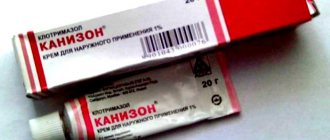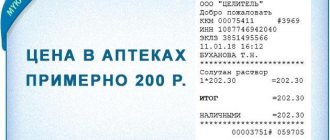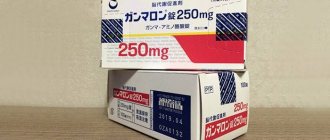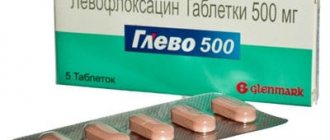Pharmacological properties of the drug Ga-40
Pharmacodynamics . Antineoplastic drug. It has a cytostatic effect against tumor cells. It has an immunocorrective, immunomodulatory effect and is characterized by a pronounced effect on humoral and cellular immunity. Normalizes the indicators of T- and B-cell immunity. Helps normalize quantitative indicators of leukocytes, T-lymphocytes, including T-active, T-helper, T-cytotoxic, T-suppressor, normal killer (NK) cells, macrophages, platelets, eosinophilic and basophilic granulocytes, band and segmented neutrophils granulocytes, monocytes; GA-40 restores the content of immunoglobulins in the blood, reduces the erythrocyte sedimentation rate, stimulates the production of cytokines, including interferons and tumor necrosis factor (TNF-α). Unlike chemotherapy drugs, GA-40 does not have a negative effect on normal cells of the body. GA-40 normalizes biochemical blood parameters disturbed as a result of the influence of various negative factors: the content of total protein, albumin, globulins, urea, creatinine, total bilirubin, free and bound bilirubin, glucose, as well as the following marker enzymes: ALT, AST, ALP, γ -glutamine transpeptidase. When treated with GA-40, positive dynamics of ranceroembryonic antigen (CEA), α-fetoprotein (AFP), prostate-specific antigen (PSA) and other specific tumor markers were noted. GA-40 also has a positive effect on the blood levels of sodium, calcium, potassium and other minerals. The drug helps to increase the effectiveness of radiation and chemotherapy while reducing the severity of its adverse side effects. GA-40 reduces the expression of adhesion molecules of tumor cells, endothelium and other tissues, which helps slow down the rate of progression of the primary tumor and metastasis. During chemotherapy, it helps to increase the resistance of the hematopoietic system to the action of cytotoxic drugs. Improves the rheological properties of blood and microcirculation, which promotes the removal of toxic products and improves tissue trophism. The drug is characterized by pronounced immunomodulatory properties.
Results and its discussion
After undergoing neoadjuvant treatment with GA-40 (an average of 18–20 injections), all patients did not complain of a negative change in general somatic status, and no cases of individual intolerance were noted. In the absence of any iatrogenies, all patients paid attention to the improvement in their psycho-emotional status; by the day of surgery, the hemoglobin level was within normal limits, the content of lymphocytes in the blood was normalized (9 patients had lymphocytopenia at the time of their initial visit to the institute), the ESR decreased, which before admission of the drug was elevated in 8 patients.
The therapeutic pathomorphosis of MK, determined by GA-40, during microscopic analysis of specimens of removed tumors, represents a wide range of alternative destructive changes in neoplastic parenchyma and non-tumor stroma, which, in terms of qualitative and quantitative characteristics, have fundamental differences from MK of patients whose treatment began with surgical removal (group control). The main phenomena (equivalents) of the therapeutic pathomorphosis of MK, which are characterized by constant detection in all patients, are immune saturation of the tumor stroma with the phenomena of cytolysis of the tumor parenchyma, hemolymphovascular disorders of the microcirculation, necrosis of the tumor parenchyma, numerous figures of apoptosis and pathological mitoses of tumor cells, fibrosis. These pathomorphological changes are virtually absent in the control group. We consider it appropriate to present the morphological argumentation of the therapeutic effectiveness of GA-40 in illustrative form (Fig. 1–16).
Lymphoid cells penetrate the walls and are located around the walls of blood (Fig. 1–3) and lymphatic (Fig. 4) vessels. Lymphoid cell infiltrates saturate the tumor stroma (Fig. 5) and in some areas cause cytolysis of the tumor parenchyma (Fig. 6). The lytic properties of the drug determine the development of induced necrosis of the colliquation type (Fig. 7, with the phenomena of karyolysis (Fig. 9, 10). In one field of view of the microscope, one can see combinations of various forms of pathological mitoses of tumor cells with apoptosis (Fig. 11, 12). Another the type of irreversible changes in the tumor parenchyma - coagulation - is somewhat less common (Fig. 13).Therapeutic pathomorphosis of MK in the desmoplastic phase of delayed morphological events is naturally manifested by the formation of granulation tissue (Fig. 14), limitation of areas of immune damage to the tumor parenchyma by proliferations of more mature connective tissue (Fig. 14). 15), the development of perivascular sclerosis (Fig. 16). Morphometric calculations of residual structurally viable tumor parenchyma according to the criterion of “intact nuclei” (absence of karyopyknosis, karyolysis, karyorrhexis) were carried out on 10 MK of epithelial-like structure. The proportion of such residual tumor component in MK is 31.3 ± 7.8% compared to the historical control group - 67.5 ± 8.1% (P < 0.05). The obtained data from the quantitative analysis convincingly demonstrate the anti-blastoma properties of the drug, the tumor-tropism of which is beyond doubt due to the two-fold decrease in the content of tumor parenchyma in the MC. Achieving such an effect of MV devitalization at the preoperative stage of treatment allows us to hope for a reduction in the incidence of metastatic risk after surgical interventions. Thus, among 10 patients with MC without metastases at the start of neoadjuvant treatment with GA-40, regional and distant metastases did not develop within a year after surgery.
Lymphoid cell infiltrates saturate the tumor stroma (Fig. 5) and in some areas cause cytolysis of the tumor parenchyma (Fig. 6). The lytic properties of the drug determine the development of induced necrosis of the colliquation type (Fig. 7, with the phenomena of karyolysis (Fig. 9, 10). In one field of view of the microscope, one can see combinations of various forms of pathological mitoses of tumor cells with apoptosis (Fig. 11, 12). Another the type of irreversible changes in the tumor parenchyma - coagulation - is somewhat less common (Fig. 13).Therapeutic pathomorphosis of MK in the desmoplastic phase of delayed morphological events is naturally manifested by the formation of granulation tissue (Fig. 14), limitation of areas of immune damage to the tumor parenchyma by proliferations of more mature connective tissue (Fig. 14). 15), the development of perivascular sclerosis (Fig. 16). Morphometric calculations of residual structurally viable tumor parenchyma according to the criterion of “intact nuclei” (absence of karyopyknosis, karyolysis, karyorrhexis) were carried out on 10 MK of epithelial-like structure. The proportion of such residual tumor component in MK is 31.3 ± 7.8% compared to the historical control group - 67.5 ± 8.1% (P < 0.05). The obtained data from the quantitative analysis convincingly demonstrate the anti-blastoma properties of the drug, the tumor-tropism of which is beyond doubt due to the two-fold decrease in the content of tumor parenchyma in the MC. Achieving such an effect of MV devitalization at the preoperative stage of treatment allows us to hope for a reduction in the incidence of metastatic risk after surgical interventions. Thus, among 10 patients with MC without metastases at the start of neoadjuvant treatment with GA-40, regional and distant metastases did not develop within a year after surgery.
The above picture of the therapeutic pathomorphosis of MK is not so significant and demonstrative when studying metastases in the lymph nodes that occurred before the start of neoadjuvant treatment with GA-40. Changes in the form of small-focal necrosis of only individual groups (complexes) of cells have been recorded; the presence of single cells in a state of apoptosis or pathological mitoses is not a natural phenomenon, so characteristic of primarily localized MK without metastases.
Use of the drug Ga-40
GA-40 is used in the form of subcutaneous or intramuscular injections. 1 bottle of the drug contains 1 mg of a complex of plant polypeptides. Add 5 ml of water for injection to the bottle with lyophilized powder and shake gently until the powder is completely dissolved. For precise dosage, it is recommended to use a tuberculin syringe; the dose of 1 ml is 200 mcg, 0.005 ml is 1 mcg, respectively. The dose for one injection is 2 mcg/kg body weight 1 time per day, preferably at the same time. The recommended dose for severe patients is 1 mcg/kg. The maximum daily dose is 160 mcg. The duration of treatment for benign and malignant neoplasms is 7 courses with an interval of 10–14 days. The course of treatment consists of 21 injections according to the standard regimen: one injection once a day for 14 days, the subsequent continuation of the course of treatment is 7 injections every other day. Further treatment is continued as follows: 2–3 courses according to the standard treatment regimen; 4–5 courses of 2 injections per week; 6–7 courses of treatment, 1 injection per week. For children over 3 years of age, the dose is 1 mcg/kg body weight 1 time per day according to the standard regimen. The maximum daily dose for children is 35 mcg. When carrying out prolonged treatment to prevent metastasis, the recommended dose is 1 mcg/kg body weight 1 time per day. To prevent relapses, the course of treatment is repeated every 2–4 months.
general characteristics
main physical and chemical properties: lyophilized white powder with a specific odor;
COMPOSITION: 1 bottle contains 1 mg (1000 μg) of the GA-40 polypeptide complex isolated from the extract (1:40) of Polgonatum varticillatum; excipients: sodium chloride, potassium dihydrogen phosphate.
Release form. Lyophilized powder for the preparation of solution for injection.
Pharmacotherapeutic group. Antineoplastic drug. AST code L01С.
Special instructions for the use of the drug Ga-40
Injections of the drug GA-40 are recommended to be carried out at the same time of day. It is recommended to use the drug both before and during radiation and chemotherapy, and after its completion. The administration of GA-40 together with radiation and chemotherapy significantly reduces its toxic effect, while the possibility of its implementation and effectiveness increase. There was no effect on the ability to drive vehicles or operate machinery. Drinking alcohol during treatment is not recommended.
Indications
GA-40 is used:
In the treatment of malignant tumors.
GA-40 gives a chance to improve the condition of patients even with advanced tumor processes, in the treatment of which the possibilities of basic traditional methods have been exhausted. GA-40 is characterized by a double effect on tumor formations: a direct necrotic effect on tumors of epithelial tissues of all organs (i.e. on carcinomas, but GA-40 has no direct effect on sarcomas - connective tissue tumors), and indirect, through the activation of an antitumor immunity to tumors of all organs and types, except for some types of leukemia. GA-40 inhibits the growth of malignant cells, promotes regression of tumors and resorption of metastases, reduces pain, improves the quality of life and significantly increases the life expectancy of patients.
The use of GA-40 is recommended before surgery, since with the formation of a primary malignant tumor, latent metastases in the body are already common (70% of cases), although their progressive development is suppressed by this primary tumor. Moreover, the primary tumor reduces or even disables the antitumor mechanisms of the immune system. GA-40 normalizes the immune system and promotes the resorption of hidden metastases, thereby localizing the primary tumor.
The use of GA-40 is also recommended after surgery, since postoperative stress, especially in the first week, usually causes a significant decrease in immunity, which increases the risk of developing infections and new metastases. Postoperative use of GA-40 prevents the spread of metastases and also accelerates postoperative recovery processes.
The use of GA-40 is recommended both before the start of radiation and chemotherapy, during them, and after their completion.
The toxic effects of chemotherapy and radiotherapy on the body of cancer patients often cause severe complications and therefore forced delays or even termination of treatment. Another problem is the initial resistance of some tumor cells to the drugs used, as well as resistance acquired during treatment. Radiotherapy and chemotherapy also cause genetic mutations in normal cells and, as a result, the likelihood of the appearance of qualitatively new types of tumors increases.
The use of GA-40 in combination with radiotherapy and chemotherapy significantly reduces the toxicity of these therapies, their usability and effectiveness are increased; the body is largely protected from the appearance of new tumors.
In the treatment of certain types of leukemia.
GA-40, as monotherapy or in combination (in combination) with other types of therapies, is used in the treatment of acute myeloblastic and megakaryoblastic leukemia. When using the drug GA-40, stimulation of hematopoiesis processes is observed, as well as the transformation of malignant cells into normal cells of the body.
In the treatment of benign and other neoplasms - mastitis, fibroma, fibroids, adenoma, cystosis, etc.
In the treatment of allergic diseases - bronchial asthma, etc.
In the treatment of infectious and inflammatory diseases, acute and chronic viral hepatitis (Hepatitis A, B, C), cirrhosis of various origins, pneumonia, bronchitis, tuberculosis, gastric and duodenal ulcers, cholecystitis, prostatitis, trichomoniasis, chlamydia, toxoplasmosis, cystitis, etc. )
GA-40 is used for preventive safe treatment of genetic predisposition to tumor diseases that are closely related to unfavorable environmental factors. At any age, hundreds of degenerating and cancer cells are formed in the human body every day, which in people with a normal immune system are instantly recognized and destroyed. The likelihood of tumors occurring in the body of people with weakened and, even more so, defective immunity is quite high. In order to reduce the risk of cancer and nonspecific diseases, as well as to increase the body's resistance to viral and other infectious diseases, it is recommended to conduct a course of treatment with GA-40 twice a year, especially for persons over the age of 40-50 years.
Evaluation of the therapeutic mono-effect of GA-40 on stage 3-4 cancer patients.
- Best effect (significant improvement) – 12%
- Good effect (improvement) - 33%
- Satisfactory effect (process stabilization) -46%
- No effect - 9%
- Negative effect (deterioration) - 0%
pharmachologic effect
The drug GA-40, being an antitumor drug, is characterized by cytostatic activity and is capable of normalizing quantitative blood parameters, improves the general condition of patients with tumor processes, delays the growth and development of malignant cells, reduces pain, promotes regression of tumors, increases the life expectancy of patients, normalizes the immune system, accelerates recovery processes in the postoperative periods. Also, the drug GA-40 can significantly reduce toxic manifestations after chemotherapy or radiotherapy. The drug GA-40, thanks to its active active ingredients, is able to resolve hidden metastases and prevent their spread. During treatment with the use of the drug GA-40, an active transformation of malignant cells into normal cells can be observed, thereby stimulating the processes of hematopoiesis.
In addition, the medical drug GA-40 can be used to reduce the risk of developing nonspecific or oncological diseases and increase the overall resistance of the patient’s body to infectious and viral diseases.










